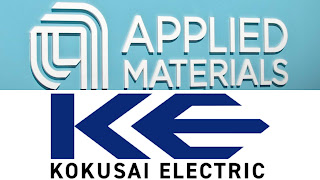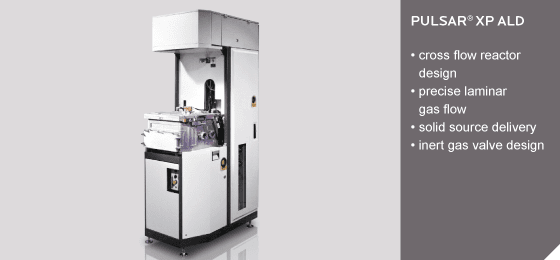Wednesday, March 31, 2021
Canada's Gratomic Enters EV Battery Supply Chain With Forge Nano and ALD
Tuesday, March 30, 2021
Picosun Group demonstrates strong growth in 2020 - Turnover grew by 38,6%
• Order intake grew by 48,4% and was €40,9M (€27,5M)• Turnover grew by 38,6% and was €37,6M (€27,1M)• Operating profit was €0,9M (€-0,3M), which is 2,5% (-1,1%) of the turnover
Almost a fifth of company’s turnover to research and development
Friday, March 26, 2021
Samsung confirms first HKMG for DDR5 DRAM
ASM International recently acknowledged that ALD High-k/Metal Gate (HKMG) is finally in high volume production for DRAM (LINK). Now Samsung confirms that. This is a small victory for all people working on this process for such a long time. My first tool ownership when I moved to Germany and started at Infineon was an ASM Polygon 200 mm cluster with a Pulsar 2000 chamber running HfO2, TiN, TiHfN, TiAlN, Al2O3, and my not fully understood HfN ALD process and a Poly chamber that I never really cared too much about. Press release below - and now do the maths - how big this business is once rolled out for all DRAM technologies to come - yeah $$$, many tulips indeed.
Samsung Develops Industry’s First HKMG-Based DDR5 Memory; Ideal for Bandwidth-Intensive Advanced Computing Applications
512GB capacity DDR5 module made possible by an 8-layer TSV structureHKMG material reduces power by 13 percent while doubling the speed of DDR4
Thursday, March 25, 2021
Forge Nano on ALD for Radio frequency (RF) and power electronics
Check out this fast ALD-Beast: LINK
- Hermetic sealing encapsulation layers with minimal thickness
- Pristine conformality in high-aspect ratio structures
- Ultra-low particle generation
- Low stress films
- Improved lifetime of circuits and PCBs
- Increased resistance to harsh environments
- No peeling or flaking of the hermetic seal at atmospheres >1200 PSI
- Negligible mass gain from coating at 100 nm
Wednesday, March 24, 2021
Canon, SCREEN and Tokyo Electron to join Japan advanced chipmaking project for 2nm
Intel is spending $20 billion to build two new chip plants in Arizona
Alex Tregub, PhD Staff Engineer Intel Corporation "From Egyptian Royal Cubit to SEMI Guides for CMP consumables – Industry Standards"
- Intel invests $20 billion in two Arizona factories, 7nm chips coming in 2023
- Intel announces steps to boost chip manufacturing
- ‘Intel is back:’ New CEO’s plan to make chips for others excites investors
- Stocks making the biggest moves after the bell: GameStop, Adobe, Intel
- Intel is spending $20 billion to build two new chip plants in Arizona
Applied Materials may kill $3.5B buy of Japanese ALD and CVD Furnace Company Kokusai over delayed approval by China
- Kokusai is a small acquisition for Applied materials as compared to the previously failed mega-merger with Tokyo Electron
- Kokusai, which counts Samsung, SK Hynix, Toshiba, and Micron among its top customers, reported revenue of $1.24 billion as of March 2018.
- Kokusai’s batch wafer processing tools are less technology-intensive than Applied Materials’ single wafer tools, the recent focus on ultra-thin films has driven renewed interest in this group.
Friday, March 19, 2021
Picosun Group is among the 10 biggest patent applicants in Finland
Woxna AB in Sweden & Forge Nano USA to evaluate ALD coated graphite anode material for Lithium batteries
Thursday, March 18, 2021
AlixLabs AB launched ALE Pitch Splitting (APS) for the first time at ALD & ALE Ireland 2016
We did not want to steal the thunder from our good Irish friends and St. Patrick Day we wish you all a healthy recovery today and breakfast for Champions. Yesterday we remembered our trip to Dublin and launching our proprietary technology, APS - ALE Pitch Splitting, for the first time to a bigger audience. Since then a lot of things has happened at AlixLabs AB in Lund, Sweden:
- We received soft funding and invest support to found the company by LU Holding (LINK) - AlixLabs AB in Lund, Sweden operating out of IDEON Science park (LINK) and Lund Nano lab at Lund University
- We received SwedishVinnova grant for "Innovative startups" 93 startup-bolag får dela på 28 miljoner | Vinnova
- We hired our first Full-time employee Dr. Mohammad Karim, Principal Scientist (LINK)
- We signed an agreement to use the lab facilities of Sweden’s largest research environment for nanoscience and nanotechnology - Lund Nano Lab (LINK)
- We applied for an Additional 2.7 MSEK EU and National Swedish Soft co-funding in early 2021 and have additional 3 projects in the pipeline.
- We have started our 1st Investment round to close before Swedish Midsummer - please get in touch if you want a meeting! (jonas@alixlabs.com or LinkedIn: LINK)
ALE Pitch Splitting (APS) taking place at the Lund Nano Lab exhibition stand in the ALD Ireland 2016 Industry Exhibition.
Video from presentation invited given by Dr. Dmitry Suyatin LINK. Staff Engineer at Lund Nano Lab and CTO of AlixLabs AB and on the Scientific Committee of AVS ALE.
All photos above by Herr und Frau Dr. Knaut (C)2016 (https://www.katharinaknaut.com/index.php?seite=archiv&name=201608jonasald)
Get your ALD-VIP Coupon Code for The Critical Materials Conference CMC2021, 14-15 April 2021
Hey ALD Folks The Critical Materials Conference CMC2021, 14-15 April is coming up with some really powerful guest that will give you deep insights beyond the typical ALD conference offering on topics lie the semiconductor and global economics, Logic Foundry High Volume Manufacturing, Cost of Quality, Metrology and Big Data Machine Learning and Data Crunching for Plasma ALD.
ALD-VIP Coupon Code: Connect2Techcet-75
Carefully selected and invited talks for the ALD-community!- Keynote: Jeanne Yuen-Hum, Vice President of Manufacturing & Operations, and Director of Global Supply-Chain Quality & Reliability, Intel Corporation on "The Cost of Quality"
- G. Dan Hutcheson & Risto Puhakka, CEO & President, VLSI Research Post Pandemic – Semiconductor Industry Trends, Chaos or Order?
- David Thompson, PhD, Managing Director, Chemistry & Device Materials, Applied Materials Maximizing Chemical Utilization & Quality in Precursor Delivery
- Lian-Chen Chi 紀良臻, PhD, Nano-Materials Center Manager, TSMC Materials Quality vs. Technology Ing. Kutup Kurt, PhD, Head of Data Science, MERCK EMD/Versum Power of Hybrid Approach for Data-driven Process Optimization in Semiconductors Industry
- Hugh Gotts, PhD, International Fellow, Air Liquide ALD & CVD Precursors Metrology and Analytics Trends- Driving toward PPQ
- Tsuyoshi Moriya, PhD, MBA, VP Advanced Data Planning, Corporate Innovation Division, TEL The Impact of Machine Learning on Processes & Materials
As a bonus the 1st day we will have a virtual round table discussion on Materials Roadmaping in the industry. All participants are welcome to join.
Conference web for registration and agenda: https://cmcfabs.org/agenda-2021/
Tuesday, March 9, 2021
CN1 from South Korea showing all their ALD tools in a new video
Here is a nice new promotional video on CN1 ALD product offering showing a lot of detail into chambers and gas boxes for all you ALD geeks out there! CN1 was established in 2008 in Gyeonggi-do South Korea, and has a very broad ALD product portfolio including single water reactors, cluster tools and large batch ALD furnaces called Mega. Please find their complete offering here: LINK. According to the information in the video they have exported ALD tools across the globe to USA, Russia, Singapore, China and more.
ALD Stories podcast with Dr. Katja Väyrynen, Process Development Engineer at Beneq
Tutorial - ALD for energy conversion and storage applications, Prof. Adriana Creatore - Eindhoven University of technology
April 6-8 5th Area Selective Deposition Workshop (ASD 2021)
Key Deadlines: Early Registration Deadline: March 16, 2021 |
- Chris Bates, UC Santa Barbara, USA
- Fabio Grillo, ETH Zurich, Switzerland
- Ravi Kanjolia, EMD Electronics, USA
- Shashank Misra, Sandia National Labs, USA
- Ainhoa Romo Negreira, TEL, Belgium
- Tania Sandoval, Universidad Técnica, Chile
- Kavita Shah, Nova, USA
- Amy Walker, UT Dallas, USA
- Charles Wallace, Intel, USA
Saturday, March 6, 2021
ASM International confirms that ALD HKMG is in High Volume Manufacturing for DRAM - The 2nd Switch is on!
Benjamin Loh (ASMI CEO), answers on financial analyst question about if ASM has ALD tools in the field for DRAM high-k/metal gate:
"Mark thanks. So, of course, first of all, maybe let's talk about the memory parts of, in DRAM we started quite some time ago, we have been qualified for the high-k/metal gate in the DRAM periphery transistor. So right now, what you see for example, and what is called in the industry as high-performance DRAM. I think they are using our ALD for the mass for the high-volume manufacturing."
Thermal ALE of germanium rich SiGe by CU Boulder and ASM Microchemistry
Friday, March 5, 2021
EMD Performance Materials announces further investments of electronics business and new name: EMD Electronics
- New name reflects the product and service portfolio designed to enable the future of electronics in a data-driven world
- Investment into R&D and innovation centers in Tempe and Silicon Valley
- Patterning, deposition and spin-on dielectrics materials to make 3D NAND possible
- DSA – revolutionary way of building microchips of the future
- OLED for brighter, thinner, free-form displays
- Liquid crystals for electronic steerable antennas to bring connectivity to places currently not reachable
- eyerise ® liquid crystal for greener windows and innovative building architecture
Monday, March 1, 2021
Welcome to the RASIRC ALD Oxide Wizard
- Direct theoretical comparison between water and hydrogen peroxide
- Allows for rapid screening of possible precursors
- Allows for lower cost precursors to be used where previous water reactivity was too low
- Allows for visualization of precursors to better understand steric hindrance effects



%20(1).png)
































